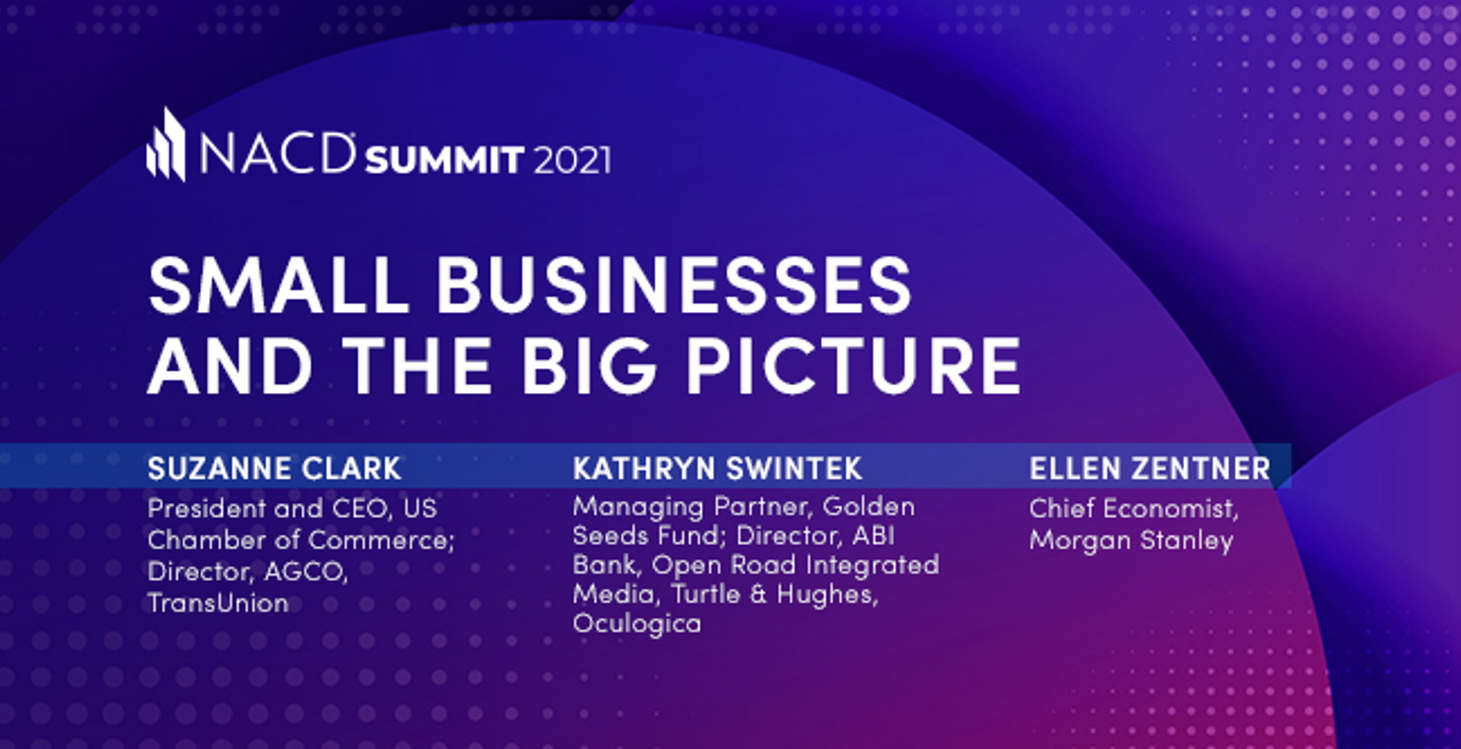
Governance Surveys
What do the 2020 Directorship 100 Private Company Director of the Year, the president and CEO of the US Chamber of Commerce, and the chief US economist at Morgan Stanley have in common? All three spoke during this year’s virtual NACD Summit on a panel titled “Small Businesses and the Big Picture,” which took place on Tuesday, October 5.
According to the US Small Business Administration’s (SBA) 2021 Small Business Profile, there are 32.5 million small businesses in the United States; they account for 99.9 percent of all companies in the country. In addition, small businesses employ 61.2 million people, just under half of all people employed in the United States. Meanwhile, small businesses account for 44 percent of US economic activity, per a December 2018 study by the SBA.
There’s no doubt that small businesses play an extremely important role in the US economy, as Kathryn Swintek, managing partner at Golden Seeds Fund and a director at ABI Bank, Open Road Integrated Media, Turtle & Hughes, and Oculogica, reminded the audience. But what role are they playing in the economic recovery from the COVID-19 pandemic? And what is the outlook for small businesses in the short and long term?
Moderated by Swintek, panelists Suzanne Clark, president and CEO of the US Chamber of Commerce and a director at AGCO Corp. and TransUnion, and Ellen Zentner, chief US economist at Morgan Stanley, shared their thoughts.
Small Businesses in the Economic Recovery
In spite of, or perhaps spurred by the pandemic, US Census Bureau data show that 4.4 million new businesses were created in 2020—a number that’s more than 50 percent higher than the latest 10-year average. “Sometimes people think of big business and small business as really different, but the truth is they’re each other’s customers and suppliers and vendors,” said Clark, “so that participation—starting those new businesses—is so important [not only] to the whole ecosystem of business but also to the ecosystem of the whole country.”
In this way, and considering how many people small businesses employ, Clark believes they have been critical to the US recovery.
Zentner pointed out, however, that on paper small businesses’ influence may be inflated. “Small businesses lost the most jobs in the downturn, so it’s not that difficult to gain the most jobs as we came out from under the lockdown last year and started to try to get the economy rolling again.”
Indeed, despite government aid, and in particular the SBA-backed Paycheck Protection Program (PPP), which was rolled out last year and provided companies with just under $1 trillion, there is a limit to the kind of impact that small businesses can withstand. Some small businesses were shuttered during the lapse of time between applying for these PPP funds and receiving them. Many more were lost to other pandemic-induced or accelerated stressors, which means that the economic recovery will still take time, regardless of government aid.
The Labor Market
The United States has 10.1 million job openings and only 8.4 million unemployed people. An August survey by the National Federation of Independent Business found that 50 percent of small businesses had job openings that they could not fill, marking a 48-year high. “The extent of the labor shortage and this recovery seem to be greater than in past recoveries,” Swintek commented in conversation with the panelists.
There will be a high volume of permanent departures from the labor market as a result of the pandemic, Zentner replied. To combat this, the US Federal Reserve System’s framework of “maximum employment” targets not just a low unemployment rate, but also as inclusive a recovery in the labor market as possible—and they’re willing to run a high-pressure economy for as long as needed to fill jobs. In the Fed’s and Zentner’s minds, getting people back into the labor market and fully employed can be the salve to the country’s current economic woes.
That said, looking at labor shortages particularly in the realm of small business, there’s a skills mismatch across certain sectors. For example, Zentner noted, the skills needed in the service sector do not necessarily overlap easily with the skills required in other sectors, which makes it harder for workers to move out of the service industry. This, in turn, means that it will take longer for labor supply issues to resolve.
For Clark, getting workers back into the labor market will require eliminating barriers to jobs. Businesses will have to think about childcare in different ways, and also consider skills training, what jobs require degrees, what apprenticeships could look like, and more.
One silver lining of the pandemic, Zentner added, is that as working from home has become more normalized, the labor market may see greater numbers of women and disabled entrants.
The Long-Term Effects on Small Businesses
With supply chain disruptions that are lasting longer than anticipated, accompanied by price increases that are hoped to be transitory, small businesses are hit especially hard. For them, it’s all about margin pressures and labor constraints. A recent MetLife and US Chamber of Commerce Small Business Index finds that 73 percent of small business owners reported significant business impacts as a result of rising prices. We should not forget, however, that in a more positive light the pandemic engendered small-business innovation and digital transformation for some.
As for looking ahead to the end of this year and the beginning of the next, Zentner does not expect another recession because she does not expect another lockdown like last year’s. Just past the peak of the Delta variant, Zentner feels generally positive about the direction of the economy. “The ride down [from the Delta peak] will be bumpy, but it will give us a sigh of relief…. There’s still a lot of uncertainty around the outlook, but I do remain fairly constructive here.”
Clark said of her work at the Chamber, “We wake up every day to say: What can we do to make Ellen’s predictions come true? What can we do to have a more optimistic view of the economy?” For Clark and her organization, pushing through the infrastructure bill still awaiting congressional approval, limiting further government taxing and spending sprees, and addressing the workforce crisis are all essential to a brighter outlook.

Mandy Wright is senior editor of Directorship magazine.
